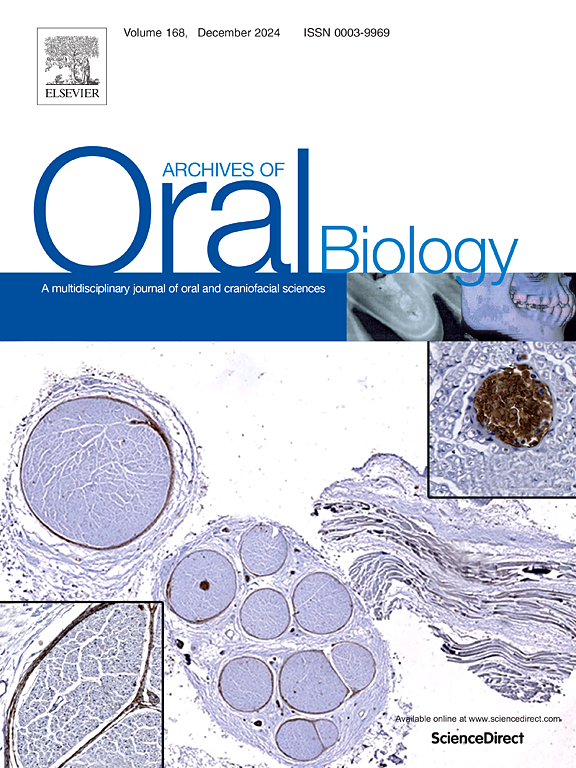Comparison of dose and time effects of flavonoids, alone or in combination, on the induction of mineralization markers in human osteoblast-like cells
IF 2.1
4区 医学
Q2 DENTISTRY, ORAL SURGERY & MEDICINE
引用次数: 0
Abstract
Objective
This study compared the cytotoxicity, alkaline phosphatase (ALP) activity, and mineralization-inducing effects of flavonoids on human osteoblast-like Saos-2 cells.
Design
Saos-2 cells were treated with quercetin, myricetin, pinocembrin, kaempferol, isoquercitrin (Iso), rutin (Rut), taxifolin (Tax), ampelopsin (Amp), epigallocatechin-3-gallate (EGCG), and chrysin at 100, 50, and 25 µM for 48 h. Metabolic activity, ALP activity and mineral deposition were assessed via resazurin, thymolphthalein and Alizarin Red S staining assays, respectively, after 8 and 14 days. Calcium hydroxide was used as positive control, and untreated cells (DMEM) as negative control. Based on initial screening, Tax, Iso, Rut and Amp were selected for double combination treatments (at 50/50 µM and at 25/25 µM), and the same assays were performed. Data were analyzed using ANOVA and Tukey's test (α = 0.05).
Results
Comparing the flavonoids, regardless of time and concentration, only chrysin at 100 µM and 50 µM significantly reduced cell viability. Iso, Rut, Tax, and Amp exhibited the highest ALP activity and mineralized nodules formation, significantly outperforming the other flavonoids and DMEM control, particularly at 50 and 25 µM (p < 0.05). Among the combinations, Tax+Iso, Tax+Amp and Tax+Rut, at 25/25 µM demonstrated higher ALP activity and enhanced mineral deposition compared to the other flavonoid combinations and DMEM (p < 0.05).
Conclusions
Based on this preliminary in vitro model, Tax, Iso, Rut, and Amp, both individually and in combination, effectively promote biomineralization in Saos-2 cells, without inducing cytotoxic effects. These flavonoids hold significant potential for osteogenic applications, warranting further in vivo studies and clinical trials to optimize their therapeutic use.
黄酮类化合物单独或联合使用对诱导人成骨样细胞矿化标志物的剂量和时间效应的比较
目的比较黄酮类化合物对人成骨样Saos-2细胞的细胞毒性、碱性磷酸酶(ALP)活性和矿化诱导作用。设计saos -2细胞分别用槲皮素、杨梅素、松皮素、山奈酚、异槲皮素(Iso)、芦丁(Rut)、杉木素(Tax)、葡萄素(Amp)、表没食子儿茶素-3-没食子酸酯(EGCG)和金菊素在100、50和25 µM下作用48 h。8 d、14 d后分别通过resazurin、thymolphthalin和茜素红S染色法测定代谢活性、ALP活性和矿物质沉积。以氢氧化钙为阳性对照,未处理细胞(DMEM)为阴性对照。在初步筛选的基础上,选择Tax、Iso、Rut和Amp进行双联合处理(50/50 µM和25/25 µM),并进行相同的分析。数据分析采用方差分析和Tukey检验(α = 0.05)。结果对比黄酮类化合物,无论时间和浓度如何,只有100 µM和50 µM的菊花素显著降低细胞活力。Iso、Rut、Tax和Amp表现出最高的ALP活性和矿化结节形成,显著优于其他黄酮类化合物和DMEM对照,特别是在50和25 µM时(p <; 0.05)。在25/25 µM组合中,Tax+Iso、Tax+Amp和Tax+Rut与其他类黄酮组合和DMEM相比,表现出更高的ALP活性和增强的矿物沉积(p <; 0.05)。结论在初步体外模型的基础上,Tax、Iso、Rut和Amp单独或联合使用均能有效促进Saos-2细胞的生物矿化,且不诱导细胞毒性作用。这些类黄酮具有成骨应用的巨大潜力,需要进一步的体内研究和临床试验来优化其治疗用途。
本文章由计算机程序翻译,如有差异,请以英文原文为准。
求助全文
约1分钟内获得全文
求助全文
来源期刊

Archives of oral biology
医学-牙科与口腔外科
CiteScore
5.10
自引率
3.30%
发文量
177
审稿时长
26 days
期刊介绍:
Archives of Oral Biology is an international journal which aims to publish papers of the highest scientific quality in the oral and craniofacial sciences. The journal is particularly interested in research which advances knowledge in the mechanisms of craniofacial development and disease, including:
Cell and molecular biology
Molecular genetics
Immunology
Pathogenesis
Cellular microbiology
Embryology
Syndromology
Forensic dentistry
 求助内容:
求助内容: 应助结果提醒方式:
应助结果提醒方式:


